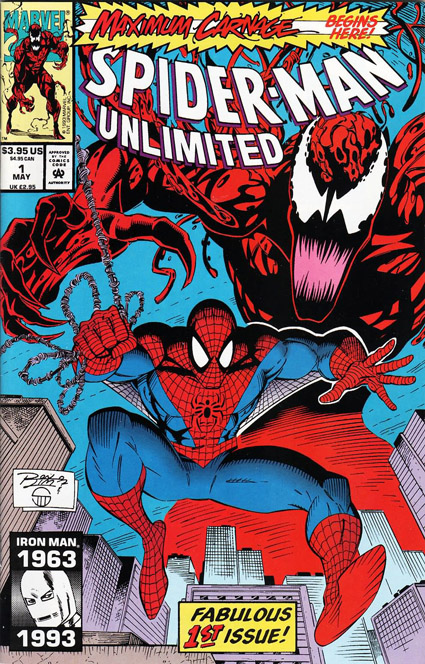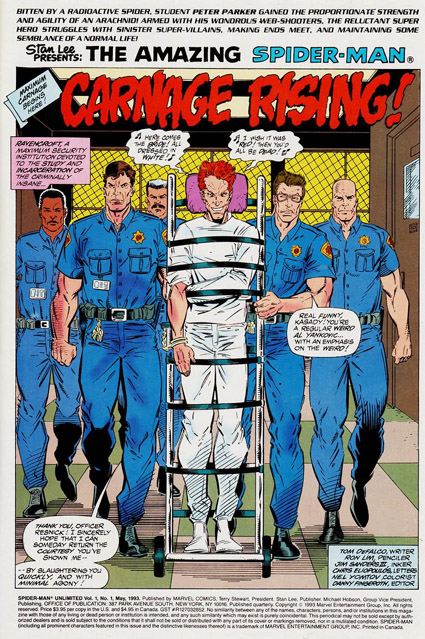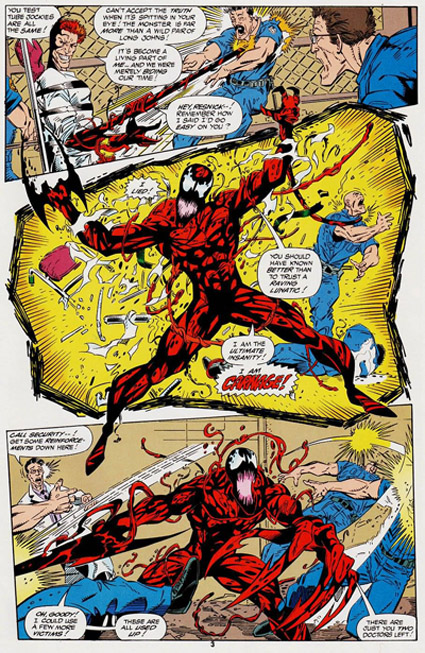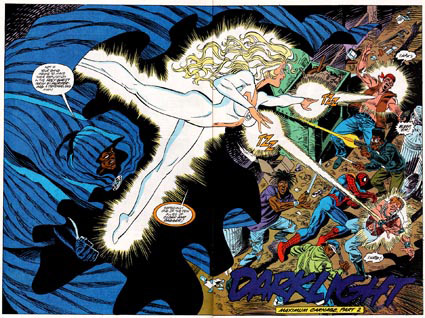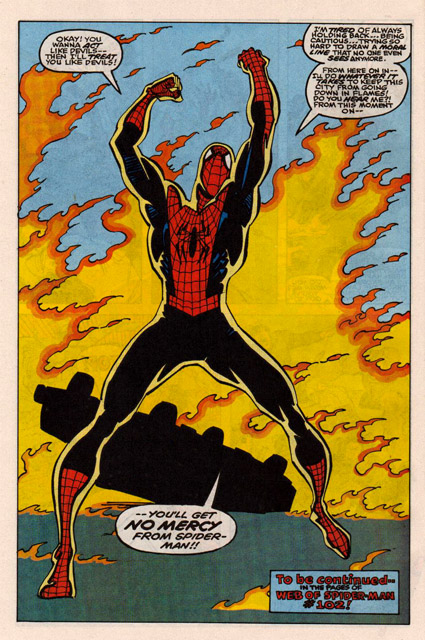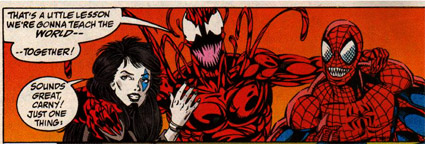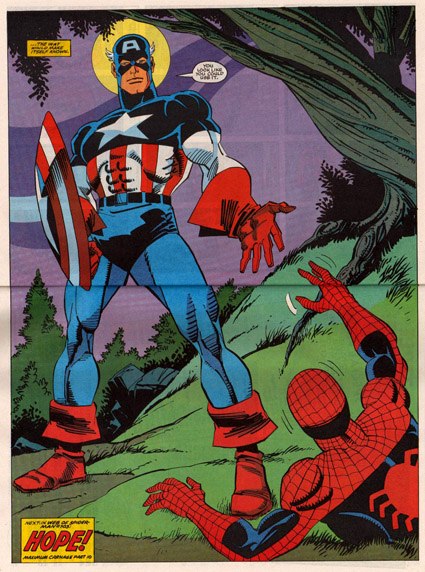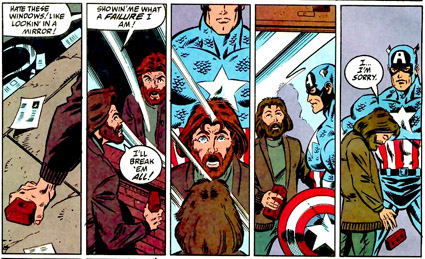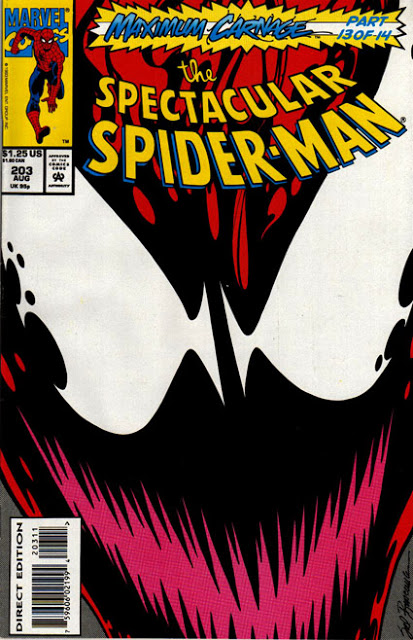The ’90s weren’t the greatest period in comic books, particularly superhero comics.
The speculator boom shifted the focus from quality to collectibility, and companies boosted sales using various gimmicks to inflate the “value” of their books for collectors. These gimmicks ranged from variant covers to shocking plot twists that led to drastic changes in the status quo of many major characters.
Mostly, characters were killed or disabled and replaced, only to return shortly after with some sort of cosmetic change.
Superman is the most famous of these cases, having died and been replaced by four other “Supermen.” Batman had his back broken and picked the unstable vigilante Azrael to replace him. Green Lantern went crazy after his hometown was destroyed and was replaced by a young artist, who turned out to be a pretty great character and worthy replacement, but that’s another story.
Then there’s Spider-Man, and an argument can be made that of all major superheroes, he had it worst in the ’90s.
The decade began with a series of darker challenges thrown at the hero, in keeping with the “edgier” appetites of fans and casual readers during that period. (Many of those new readers wouldn’t stay into the next decade.) While Spider-Man has historically known tragedy, his adventures took on a note of overwhelming despair. Peter Parker’s trials began with the symbiote mess, and ran through the return of his parents and ultimately the much-despised Clone Saga.
But before that bloated morass came Maximum Carnage, arguably one of the most infamous stories in Spider-Man history, and certainly the most aggressively ’90s. It was a product of a time when slapping Venom or Carnage on a Spider-Man cover was a license to print money, and it paid off at the time for Marvel: not only did the 14-part crossover put up big numbers for the Spider-Man line, but it became a cross-platform success too, spawning a popular video game. (That’s another story in itself.)
Nowadays, Maximum Carnage gets a bad rap in large part because it is such a product of its time. It’s grim, violent, and awash in references to contemporary pop culture, not to mention Marvel continuity of the period. It takes one of the most popular characters in superhero comics–Venom–and threatens to overexpose him.
But is it really as bad as its reputation suggests?
Here’s the thing: I never read Maximum Carnage in its entirety. I remember the first part very well, because I owned it. It was the lead story in the first issue of Spider-Man Unlimited, a quarterly Spider-Man anthology that represented the hero’s own plummet into over-exposure (one that continues to this day). Because it was a first issue, it represented that all-important quality the Big Three (and yes, Image roared out of the gate to become one of the big ones) cherished: collectibility.
And at that time, I bought into it. So I bought it.
I don’t know why I never finished the story, so I figured this would be a good time to do it. Rather than dive into this one alone, I asked T.J. to read the story too. Here’s the catch: T.J. has never read a Spider-Man comic in his life. Maximum Carnage, though it started in a first issue, was not the most welcoming story for new readers. Would it be too much to ask a total neophyte to read one of the most unapologetically ’90s of stories? I wanted to find out.
T.J.?
I’ll be frank, I was never much of a comic book guy. I loved the cartoons growing up, especially X-Men, but I never got into them. Pleading with my mom or dad to take me to the comic book store wasn’t a common occurrence. Talking to Frankie got me thinking that I definitely missed out on a lot of 90s things because I was too busy watching reruns of Saved by the Bell, Boy Meets World and whatever the dynamic duo Miller-Boyett put in front of my face.
I did play many of the video games, however, and one of them I do remember was Spider-Man and Venom: Maximum Carnage. It was a pretty cool game, I don’t remember the story at all, but remember asking mom or dad to take me to the local West Coast Video (Anyone remember that place?) and renting this and countless other games. With that, as we did last time with Xena: Warrior Princess, we’re going to cover something that I’m not familiar with because I was too busy being obsessed with Kelly Kapowski.
(For those keeping track, the last paragraph featured references to Spider-Man and Venom, West Coast Video, Xena, and Kelly Kapowski. Pretty sure that has never happened in any piece of writing in history.)
Maximum Carnage is a 14-part series where Spider-Man and Venom team up to battle Carnage, Venom’s pro-murder kid. This all starts off with Kasady in an insane asylum. One of the prison guards makes this remark, which I thoroughly enjoy.
“Real funny Kasady! You’re a regular Weird Al Yankovic…With an emphasis on the Weird!”
Hilarious…until Kasady goes CRAZY and Carnage comes out, the blood red psycho killer! As he’s going nuts, killing everyone in sight, Peter Parker and Mary Jane are at the Green Goblin’s funeral.
Sad face. Back, to the insane asylum, Carnage continues to kill guards at will. He then finds a woman in a cell named Shriek who wants to join him in the madness.
Back at the Parker residence, Mary Jane is so stressed she lights up a cigarette, causing Peter to make a public service announcement and tell her smoking is bad. The two have a heart-to-heart agreeing that Peter should take a vacation from being Spider-Man for a bit. Because dying isn’t any fun.
Spider-Man then battles Doppelganger and Shriek, breaking his promise to Mary Jane to cool it for a while with the whole fighting enemies thing. Things are looking bad for our hero as maybe his ribs are broken while Carnage continues to cause havoc, ending the first part of the series.
Part One does a satisfactory job of setting up the major players.
The story comes right on the heels of Harry Osborn’s death as the second Green Goblin. Peter Parker’s tight-knit supporting cast is feeling the impact, but only Peter and Mary Jane are able to fully grasp the impact, as no one else is aware of Peter’s dual identity.
It’s interesting to see his supporting cast at this time. Let’s check in on them, shall we?
Mary Jane Watson-Parker: Peter’s gorgeous, long-suffering wife was starring in a soap opera, Secret Hospital, at the time, and had taken up smoking, much to Peter’s consternation. Every mention of her habit was like a PSA.
Richard and Mary Parker: Peter’s parents, long assumed dead. The two were revealed to have been secret agents, captured and held for decades in a Russian prison. Their return ended up ruining everything after Maximum Carnage.
Liz Allan: Peter’s one-time high school crush married Harry Osborn. The two of them had a son, Normie, who skulked about and gave the Parkers the stink-eye. During this period, Liz’s brother Mark Roxton, the reformed villain known as the Molten Man, stood close by to offer emotional support. Mark Roxton is also one of the most soap operatic names I’ve ever seen.
Aunt May was just Aunt May. Good, old reliable Aunt May.
On the other side of the aisle, there was Carnage, the spawn of the Venom symbiote–a living blob of black goo that turned out to be an alien masquerading as Spider-Man’s second costume, which joined with sleazy journalist Eddie Brock after Peter Parker rebuffed him. Carnage was a secretion of the original symbiote, bonded with Brock’s prison cellmate Cletus Kasady after the Venom symbiote broke Brock out of prison.
Kasady was a serial killer, aspiring to be an embodiment of pure chaos.
It took the combined efforts of Spider-Man and Venom, who somehow managed to put aside their differences and stop the madman. But like any would-be cult leader, Carnage had his followers, including his sonic-blasting squeeze Shriek and an eight-armed alien doppelganger Spider-Man faced during the Infinity War. The trio formed the roots of a disturbing little family that massacred Ravenscroft at the start of the story.
One of my biggest foibles with this entire story is with the dialogue. I know: these are cape comics, so I should expect them to be on the nose. To be fair, DeFalco’s script isn’t too bad. It hits all the points it needs to hit and isn’t embarrassing. There’s also a bit of dialogue I did enjoy during the Ravenscroft sequence, but that’s probably because it references my favorite line from Commando.
“Hey Resnick! Remember when I said I’d go easy on you? I lied!”
Part Two:
Things look bad for Spider-Man. He’s surrounded by a bunch of thugs but then Cloak and Dagger come out to give a helping hand. They’re also concerned for Spidey. “These bandages are no substitute for proper medical attention,” Cloak tells Spiderman. (Pretty sure I’ve heard that line used in college at some point.)
The heroes are attacked again by Shriek and Doppleganger. Then Carnage comes in and all hell breaks loose. Looks like Dagger is taken completely out. Venom, whose demon spawn is causing this whole mess, also makes his first appearance. A lot more action in this one and a lot more superhero activity going on with Cloak and Dagger.
I’ll be honest here: I don’t care much for the Web of Spider-Man issues of this crossover. That’s largely because of the art team of Alex Saviuk and Don Hudson.
Though Saviuk isn’t terrible by any stretch, I was never a huge fan, but Hudson’s inks make things much worse. There’s no subtlety at all. Hudson’s inking is too heavy, leaving every line to blur together. That’s a shame, because the first few pages of the issue actually feature great work from Saviuk, who really has a way with Dagger. For the most part, however, it’s pretty middling work.
The first major battle of the arc features a hefty casualty in the form of Dagger, but come on, do you think her death really reads as permanent? I didn’t believe it, though it does help put Cloak into a darker place, which is apparently what the story needs to do.
Part Three:
Realized how much i’m a fan of the term “alien symbiote.” Venom explains himself a little bit, telling us he needs to take out that Carnage fellow. I feel bad for Cloak here. He gets very emotional about Dagger while Spider-Man sells his ribs. “The way Cloak teleports in and out is something I’ll never get used to!” says Spider-Man. I love cheesy lines. Mary Jane and Peter’s dilemma continue. Spider-Man really wants to save people’s lives but Mary Jane, who is becoming quite the chain smoker it seems, doesn’t want to lose him.
Spider-Man then takes on Demogoblin, saving a priest’s life. “Wha – Spider sense! An orange pumpkin bomb!”
Venom goes face to face with Carnage for the first time in this series. But then the story ends with a beat up Venom in the Parker household.
T.J. seems to be enjoying this if nothing else on a camp level. At least there’s that. The danger is ramping up considerably, as Demogoblin, yet another Goblin, makes an appearance. Hey, if you’re gonna do something successful, repeat it with endless variations.
We go from my least favorite artists of the series to my favorite in Mark Bagley. In the following decade, Bagley would make a name for himself by penciling some TEN YEARS of Ultimate Spider-Man without missing an issue, but he was already a Spider-artist I held in great regard before he took that assignment. His work is a highlight for me here.
Marvel decided to do an about-face with Venom shortly before this story, turning him into an antihero and spinning him off on his own in San Francisco. The “Lethal Protector” was another example of endless variations of decisions that worked, until they didn’t. Sabretooth and Sandman were two further examples of villains reformed into antiheroes (or straight up heroes) during the ’90s.
Part Four:
Choices, this one’s all about choices. Venom becomes Spider-Man’s frenemy and Mary Jane is worried Venom would kill her beloved husband which would make Venom the worst houseguest of all time. There’s a distrust there for obvious reasons. Spidey goes to Black Cat for some help. Spider-Man, keeping his righteousness, says if anyone tries to kill others, he’ll try to stop them no matter what side they’re on. He’s all about the people! And this one ends with our hero having to choose whether to save Cat and Venom or hundreds of innocent people Carnage is out to kill.
Obviously, the core of the story has formed, which is the ideological split between Peter Parker and Eddie Brock over their pursuit of Carnage. Parker insists there’s a line the heroes shouldn’t cross, but does Venom have a point? Do the needs of the many outweigh the needs of the few? That was a common thread through a lot of the classic hero books in the late ’80s and ’90s.
Tom Lyle handles art chores as Carnage convinces Demogoblin to join his “family.” Next to Bagley, I would say he’s one of the best pencilers in this story arc, though he’s not without his flaws, tripping up a little on some of Spider-Man’s more acrobatic poses. Then again, I can’t tell if he’s that good or if Scott Hanna’s detailed inks aren’t just making him look good.
Part Five:
Spider-Man saves Black Cat, Venom’s not all about that. There’s some infighting. Peter meets his dad and they talk about evil and how it lurks in people, closer to the surface than one might think. Carnage seems to have brought out the crazy in a lot of people in the city.
A lot of morality discussed in this chapter of the story. It ends with Spider-Man coming to a realization that he has to fight fire with fire, basically no more Mr. Nice Guy.
It’s hard for individual writers to really break out and shine on their own during these big crossovers, but J.M. DeMatteis really seems to take a big bite out of the philosophical aspects of this story. Fortunately for Peter, Carnage’s squad has its own squabbles. Carnage is espousing chaos for its own sake, but it seems more like a hateful rebuke of order thanks to past issues.
This makes him a more interesting character than the one-note homicidal maniac we usually see.
It must be noted, Sal Buscema’s art is pretty solid. His facial expressions are appropriately heightened, reminiscent of Steve Ditko himself. But while he does much to enhance the conversation between Peter and Richard Parker, the “devils” speech is kind of ludicrous, even for ’90s Marvel.
Part Six:
Mary Jane is out and about at the opening of “The Deep” which is “New York’s newest celebrity-owned midtown nightclub.” (Wonder if Bruce Willis and Sly Stallone were involved?) The Carnage crew goes in and destroys everything. Mary Jane is threatened until Venom and the gang show up. Spider-Man too eventually. He saves her and all is good. He’s a bit more badass, promising that in the last episode.
The funniest and saddest thing about this issue for me has nothing to do with the story. Rather, it’s the Bullpen Bulletins page, which that month featured an interview with Alex Hyde-White about his role as Reed Richards in the Fantastic Four movie. It’s pretty well known at this point that the movie was never intended for release, but was simply used to retain the rights to the property. Hyde-White’s apparent excitement over the film makes it that much more depressing to read, knowing what ultimately happens.
Part Seven:
Spider-Man talks a bit about the conflict with him and MJ. She wants him to take a superhero siesta, but he thinks big picture of saving lives, even if that means working with his enemy.
I do like the fact that some of the regular people in the city, frustrated and angry at what’s going on in their own lives, see Carnage as someone looking out for them, even though he wouldn’t hesitate to wipe them out. It’s a play on evil dictators I’m guessing. Firestar joins the good guys, evening things out a little bit.
This is a pretty disparate group of characters the webhead pulls together, but I remember another crossover with a similarly odd team, the little-remembered Round Robin: The Sidekick’s Revenge that ran through Amazing Spider-Man and featured Spidey teaming with Moon Knight, Darkhawk, the Punisher, Night Thrasher and Nova (Hey, remember when the New Warriors were a thing?) to take on the Secret Empire.
I have no clue why Deathlok is involved in this story, but I guess it’s all pieced together later on.
Part Eight:
“No More Mr. Nice Venom.” When was he nice?
Sonic Disruptor…hell of a weapon.
Apparently Carnage will live forever because the alien symbiote permanently altered his bloodstream. How hardcore is that? This all doesn’t bode well for mankind.
You know, forget what I said about Tom Lyle. Seeing anyone else but Mark Bagley draw this thing just makes me appreciate Bagley more and more.
Carnage’s past comes to light in this issue, making him a little more interesting, though I have to admit, I enjoy seeing DeMatteis explore that sordid history much more than Terry Kavanagh.
Part Nine:
I love conundrums. Spider-Man has to team up with some characters of questionable morality in order to save as many lives as possible by taking down Carnage and his squad. I tend to side with Venom and the rest here as Spidey uses his Spider sensibilities to rationalize working with evil to defeat evil. Kill if you have to, dammit!
Firestar was frying up Carnage but Spider-Man changes minds again about morality. Then we get the anticipated Spider-Man vs. Venom blow up. Venom swipes Spidey away and goes after Carnage and Shriek. Those sound waves nearly kills Venom but like most bad guys in these things, they don’t kill him, leaving an unncessary window for a comeback from the good guys. Spider-Man keeps saying “there must be another way” and holy f-bomb, it ends with the other way being Captain America!
My biggest problem with this storyline is that t’s so repetitive. Writers Tom DeFalco, David Michelinie, and Terry Kavanaugh set out to construct a story that took Spider-Man to his moral breaking point, and there’s a lot of hand-wringing here as Spidey agonizes over how far he’s willing to go to stop Carnage.
That’s fine, and the crew that forms to back him up for the bulk of the story–Black Cat, Morbius, Cloak, and Venom himself–certainly do much to push his ideals as far as they can go. But fourteen issues is a long time to stretch out the same moral dilemma.
It doesn’t help that each chapter seems to be the same variation on “Carnage and crew kill a lot of people, Spidey and company fight them and one side escapes.”
Sure, more characters enter the fray, and already, Iron Fist has jumped in to save Deathlok, so he’ll be joining the team soon enough. But it’s still just variations on a theme, and Peter ends up back where he started, whinging over whether he should just give in to Venom’s methods and try to end Carnage for good.
Which is why it’s such a “f*ck yeah!” moment when Captain America shows up at the end of this issue. Finally, we get a sense that things are really going to move. Even better, Peter’s beliefs are crystallized, because honestly, who in their right mind is going to argue with Captain America?
Because Cap is now involved, Peter’s beliefs are strengthened, which gives him tougher resolve to stop Carnage his way.
We also learn that the greatest threat might not be Carnage, but Shriek, who is able to influence the behavior of everyone in New York with her sonic and psychic powers. With the city tearing itself apart, it’s clear that Captain America’s appearance here is absolutely necessary.
And honestly, that double-page spread of Cap is money. Great job, Sal.
Part Ten:
Poor MJ, who now has an ashtray of cigarette butts to show that she’s become a chimney in the wake of her increased fear for Peter Parker’s life. This part is where “winning the right way” becomes a little more prominent with Captain America’s involvement and Venom out of the picture for a little bit.
I’m sorry, but Hudson’s inks are too damn heavy. Alex Saviuk is a mixed bag here as well with facial expressions and such, but he’d be so much better with another inker.
Despite my concerns over the art, the story is largely decent. Two teams of heroes are out to stop Carnage now. Spider-Man and Cap have gathered Firestar, Deathlok and Iron Fist to stop Carnage and save lives, while Venom and his crew–Black Cat, Cloak, Morbius and Nightwatch (remember him? I sure don’t) pursue Carnage with single-minded focus. Black Cat ducks out of the action after a particularly vicious beating
Part Eleven:
Carnage and some of his crew are in the flame part of the Statue of Liberty, toying with a helpless Venom.
Luckily your friendly neighborhood Spider-Man has solid, moral reenforcements.
They take down Shriek, who was all alone…um shrieking. The heroes, Deathlok, Captain America, Spider-Man, Iron Fist, slowly reverse the madness Shriek caused. They’re making the people in New York who had gone mad, realize the terrible things they’ve been doing like stealing and threatening to drop their children off the roof of high-rise buildings. The people are seeing the light. Good is slowly starting to overcome evil. Black Cat and Cloak are pondering the meaning of life as Spider-Man wishes they had a few more on their side.
It gets serious at the end as Shriek brings back the evil out from the good people, the gains of Spider-Man and the rest basically erased…What’s next?
My favorite page here is #16, where one of the looters sees Cap and instantly comes to his senses, simply apologizing.
A couple of pages later, Spider-Man stops a woman from dropping her children off of a ledge, simply by showing up. I like these moments, when superheroes can win a battle without even throwing a punch, just through example. These aren’t just crime-fighters, they’re symbols of something greater, which is probably my favorite theme of superhero comics.
Part Twelve:
Mary Jane remains hopeful, finally turning the corner on believing that Spider-Man is doing what he’s doing for the good of mankind. Speaking of Spider-Man, he continues to think about fighting fire with fire. Carnage goes Ike Turner on Shriek and the rest of his crew. In the end…Dagger lives!!
Much as I complain about Peter’s constant haranguing over what to do, I liked the couple of pages with his struggle intercut with flashbacks of his past, in addition to Cloak’s discovery. Of course, J.M. DeMatteis wrote this issue. If he wrote the entire crossover, I’d probably enjoy it five times more.
Part Thirteen:
Dagger tries really, REALLY hard to change Shriek’s heart even though she was the one who was “this” close to killing her. Didn’t work. But how about an “Alpha Magni-Illuminator?”
Carnage is dead, which isn’t what Spider-Man wanted. Not that way. But he resisted after all, Captain America putting it that Spider-Man was willing to die for what he believed in and in a twisted way, Carnage felt the same way.
Venom comes back, angry that he didn’t get the job done and Spider-Man and the crew will get the glory for his death. But, by the way, Carnage isn’t dead. Wonder how this ends?
I don’t think it’s glory Venom wanted, TJ. I think he just wanted to eat Carnage’s brain.
Ostensibly, much of the story is wrapped up here.
Shriek is offered redemption, and although she rejects it at first, she finally gives in when the heroes use the “good bomb” against everyone. Carnage is seemingly torn apart, and DeMatteis gets inside Kasady’s head to show a damaged psyche embracing evil simply because the existence of good would seem to invalidate his own existence.
In that sense, Carnage and Shriek aren’t just totally contemptible villains (though they are that, still) but also objects of pity. They’re broken people who aren’t just incapable of love, but unable to believe that any sort of order or good can thrive. It’s the “If God exists, then why does he let bad things happen?” argument. It’s not the deepest approach, but DeMatteis makes this very engaging.
Part Fourteen:
Venom wants to tear the ish out of Carnage, while Spider-Man remains steady with his ideals. Both his ribs are hurt and he’s looking for a pay phone. Also, I love that he wants to call Mary Jane to get his insurance card so he can go to the ER. Wonder if Peter Parker would be in favor of universal health care?
Venom continues to battle Carnage and Spider-Man, after some much needed rest, says he’s gonna finish the job his way. Black Cat changes her mind and joins the fray for the final battle. Venom and Carnage battle into some generators until a major explosion. That’ll do it folks. I enjoyed the series, every entertaining.
It’s the little touches, TJ. They hold everything together.
I kind of wish DeMatteis wrote the final chapter of this story.
Instead, we get the standard superhero punch-up by Tom DeFalco, although Mark Bagley graces the issue with his rough breakdowns (finished by Sam De LaRosa).
Ultimately, Peter gets through to Eddie, just enough so that he doesn’t try to finish Carnage off, and even seems to sacrifice himself to stop Kasady. Granted, neither man dies, and all’s well that ends well, except the hundred of people who’ve been senselessly murdered over the course of the story. I hope Peter can live with that.
And that’s Maximum Carnage. I’m glad it didn’t break TJ’s brain.
In the end, it wasn’t really as bad as its rep, but I didn’t think it was the best Spider-Man story either, far from it. It was, however, quintessentially ’90s, though to its detriment in ways. I had two very major problems with the whole story.
First off, it’s too damn long.
Seriously, a lot of it falls into a formula of “Carnage and crew kill people, the Spider-Squad attacks, the Carnage family retreats to kill again.” And even though a ton of characters got worked into the whole thing, plus cutaways to Peter’s family and friends, the whole thing could have been done in eight to ten issues, rather than fourteen. Heck, ten is being generous.
Secondly…it isn’t really that much fun.
Part of it is the length and crushing repetition, but much of it has to do with the fact that it’s just a whole lot of Spider-Man fighting and whining. He doesn’t even quip that much (the bulk of the wisecracks go to Carnage). Maybe it can be explained that Spider-Man would find it distasteful to joke around in the face of so much death. But that’s an integral part of the character, that the web-spinner deals with all of the death he faces with humor. He literally has to laugh to keep from crying.
Sadly, humor was in short supply during the ’90s.
Little did people know it would get worse.



































































































